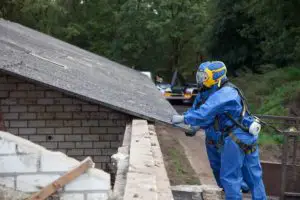Asbestos in the Home
For most of the 20th century, asbestos was heavily used for constructing new homes and buildings. It was cheap to produce and praised for its great insulant and fire-retardant qualities.
Even some of the smallest household appliances contained asbestos. Not until the late 1970s were the dangers of asbestos public knowledge, and its use became regulated by the U.S. Environmental Protection Agency (EPA).
Asbestos is a toxic substance known to cause mesothelioma, which is an aggressive cancer that forms in the narrow lining near either the lungs, abdomen or heart. Whether inhaled or ingested tiny, sharp asbestos fragments can lodge into the cellular linings of these narrow passageways.
Many asbestos companies are at fault for spending decades hiding the dangers of asbestos and continuing to manufacture this toxic substance. For this reason, mesothelioma patients can file a mesothelioma lawsuit for their disease.
Most people are exposed to asbestos through their occupation, but some people are in danger due to their residence. To understand if you’re at risk of asbestos exposure in your home, you should know where the substance is.
Where Is Asbestos Found in Your Home?
Asbestos is most often found hidden in cement, insulation, floor tiles, and walls and pipes. It’s also found near electrical wiring and sockets.
Knocking down walls or tearing out old pipes and vinyl floor tiles can release these toxic fibers into the air. Asbestos as a clumpy compound isn’t dangerous. If left undisturbed, asbestos is relatively harmless.
However, doing home repairs can disturb asbestos and cause fibers to separate from the primary source. These fibers are what we breathe in or swallow, and they can cause mesothelioma to form.
Homeowners who decide to renovate their homes might unknowingly put themselves and others in danger.
Consider leaving materials that are in good condition alone. Always assuming asbestos could be present in an older home is the key to preventing exposure when making renovations. If you’re unsure if you have asbestos in your home, hiring a professional to inspect and remove it can greatly decrease your risk of exposure.
What Household Items Contain Asbestos?
Most current everyday items will not contain any asbestos. There are some exceptions, such as talc-based products like baby powder, cosmetics and other health and beauty items.
You could still have old appliances or products that were built using asbestos and may pose a risk of exposure. Here are some common household items that may be present in different parts of your home.
Kitchen
- Potholders
- Dishwasher
- Plastic cookware
- Stoves
- Toasters
- Coffee pots
Bathroom
- Hairdryers
- Health and beauty products
- Irons
- Portable heaters
Garage
- Gloves
- Duct tape
- Brake pads for automobiles
- Fire blankets
The United States has not banned asbestos entirely from commercial use, but the substance is heavily restricted. There are many watchdog organizations testing for asbestos in commonly used and purchased items, so any company relying on asbestos is facing public criticism and dwindling profits.
Other countries may have little to no regulations on the amount of asbestos that can be used in their products, so take caution when purchasing anything from overseas.
Sources:
- Asbestos Frequently Asked Questions. Florida Department of Environmental Protection. Retrieved from:https://floridadep.gov/air/permitting-compliance/content/asbestos-faq Accessed:01/30/20
